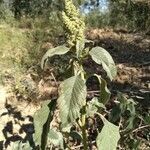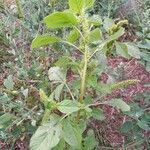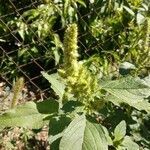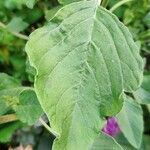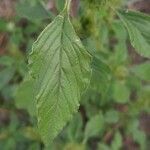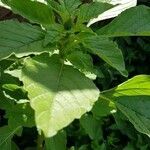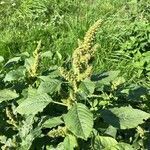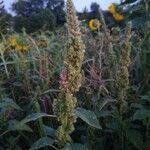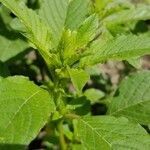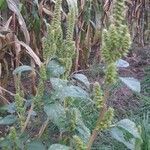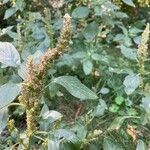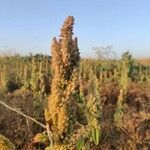Monoecious; stem stout, erect, usually branched, to 2 m; plant scurfy-villous in and for some distance below the infl; lvs long-petioled, ovate or rhombic-ovate, usually hairy beneath at least along the veins, to 10( 15) cm in well developed plants; principal infl a terminal panicle of several or many short, densely crowded, obtuse spike-like thyrses, the whole 5–20 cm; similar but smaller panicles produced from the upper axils; bracts rigid, subulate, 4–8 mm, much surpassing the cal; sep 5, those of the pistillate fls oblong-lanceolate, slightly outcurved above, rounded or truncate or emarginate at the tip, and often minutely mucronate, with simple midvein, at maturity 3–4 mm and much-surpassing the fr; stamens 5; style-branches fairly long, erect or slightly recurved; fr compressed, 1.5–2 mm, circumscissile at the middle, the upper part rugulose; seed round-obovate, 1–1.2 mm; 2n=34. Native of tropical Amer., now a common weed throughout most of the U.S. and also in the Old World.
Stem erect, light green, 20-80 cm tall, stout, branched or not, slightly obtusely angulate, densely pubescent. Petiole light green, 1.5-5.5 cm, hairy; leaf blade ovate-rhombic or elliptic, 5-12 × 2-5 cm, both surfaces shortly hairy, but densely hairy abaxially, base cuneate, margin entire and undulate, apex acute or notched, with a mucro. Complex thyrsoid structures terminal and axillary, erect, 2-4 cm in diam., including many spikes; terminal spikes longer than lateral ones. Bracts and bracteoles white, subulate, 4-6 mm, apex slenderly long pointed. Tepals white, oblong or oblong-obovate, 2-2.5 mm, membranous, with a green midvein, apex acute or notched, with a mucro. Stamens slightly longer than perianth. Stigmas 3, rarely 2. Utricles light green, ovoid, compressed, shorter than perianth, circumscissile. Seeds brown or black, subglobose, ca. 1 mm in diam., obtuse at margin. Fl. Jul-Aug, fr. Aug-Sep. 2n = 32*, 34*, 102*.
Hairy, erect, annual herb to c. 1 m high, but very variable in size; stems reddish towards base, densely hairy above. Petioles c. 5 cm long. Lamina 2-10 × 1-4.5 cm, ovate-lanceolate, becoming glabrous above; veins persistently hairy below; margin undulate, usually ciliate; base cuneate; apex obtuse. Infl. dense, spike-like, to c. 20 cm high, with numerous short lateral branches. Longer bracteoles 4-5 mm long, lanceolate-subulate with green keel; shorter bracteoles similar. Tepals 4-5, 2-2.7-(3) mm long, oblong; keel green; apex ± truncate to rounded and cuspidate. Fr. broadly ellipsoid, circumscissile, with rounded apex, included within persistent perianth except for stigma apices. Seed 1-1.3 mm diam., suborbicular or broadly ovoid, dark brown.
Flowers in greenish or rarely somewhat pink-suffused, stout, axillary and terminal spikes, which are usually shortly branched to give a lobed appearance, more rarely with longer branches, the terminal inflorescence more or less paniculate, very variable in size, male and female flowers intermixed, the latter generally much more plentiful except sometimes at the apex of the spikes.
Leaves furnished with multicellular hairs along the lower surface of the primary venation and often the lower margins, long-petiolate (petioles up to c. 6 cm., in robust plants not rarely equalling the lamina), lamina ovate to rhomboid-or oblong-ovate, (1) 5–11 × (0.6) 3–6 cm., obtuse to subacute at the mucronulate apex, shortly cuneate to attenuate into the petiole.
Perianth segments 5, those of the male flowers 1.75–2.25 mm., lanceolate-oblong, blunt to subacute, those of the female flowers 2–3 mm., narrowly oblong-spathulate to spathulate, obtuse or emarginate, more or less green-vittate along the midrib, which ceases below the apex or is excurrent in a short mucro.
An annual herb which grows to 60-90 cm high. It has furry stems. The root is usually rosy red. The leaves and stems are often quite red in colour. The leaves are oval or sword shaped. The seed spikes are green and bristly. These can be at the top of the plant or in the axils of leaves.
Bracts and bracteoles lanceolate-subulate, pale-membranous with a prominent green midrib excurrent into a stiff, colourless arista, longer bracteoles subequalling to twice as long as the perianth.
Annual herb, erect or with ascending branches, (6) 15–80 (100)cm., simple or branched (especially from the base to about the middle of the stem).
Capsule subglobose, c. 2 mm., usually shorter than the perianth, circumcissile, with an indistinct neck, rugose below the lid.
Seed black and shining, compressed, c. 1 mm., almost smooth centrally, faintly reticulate around the margins.
Stem stout, subterete to angled, densely furnished with multicellular hairs.
Stigmas 2–3, patent-flexuose or erect, c. 1 mm.
